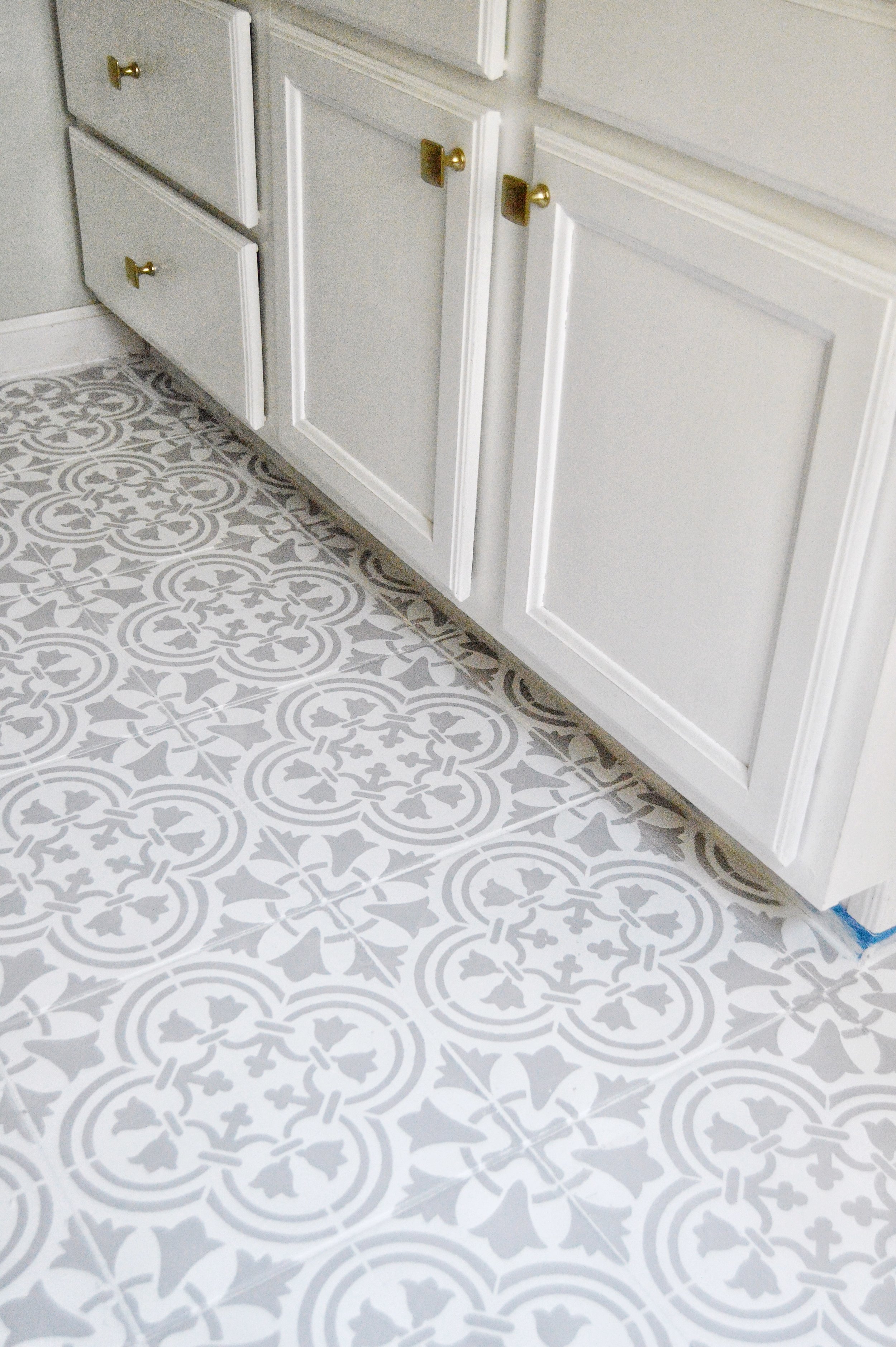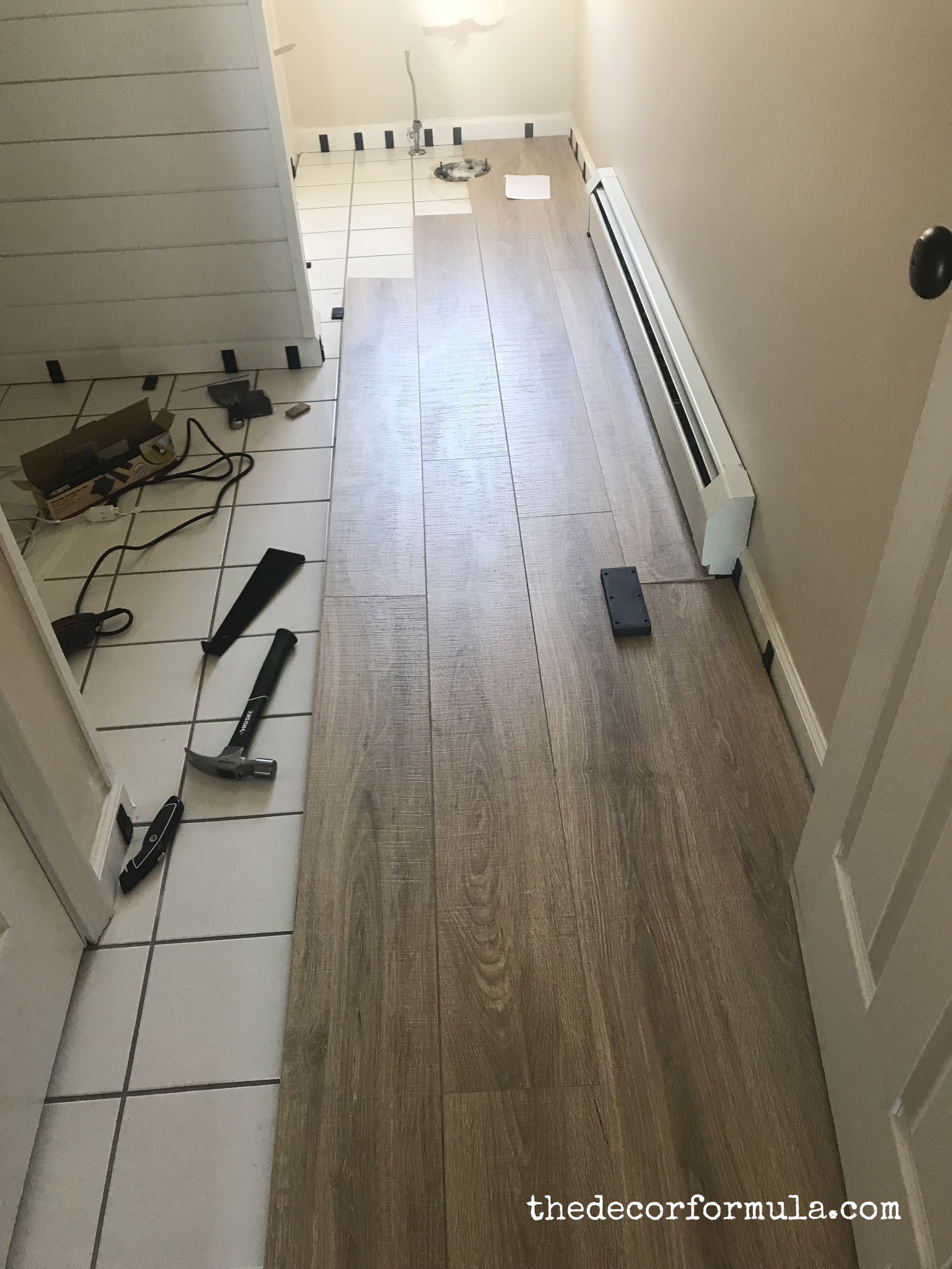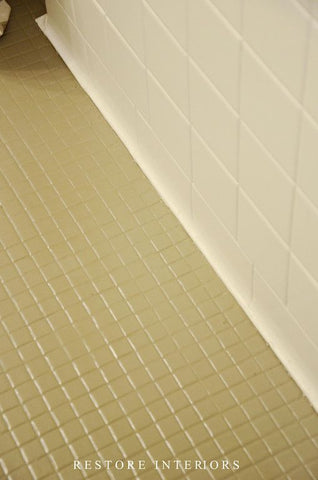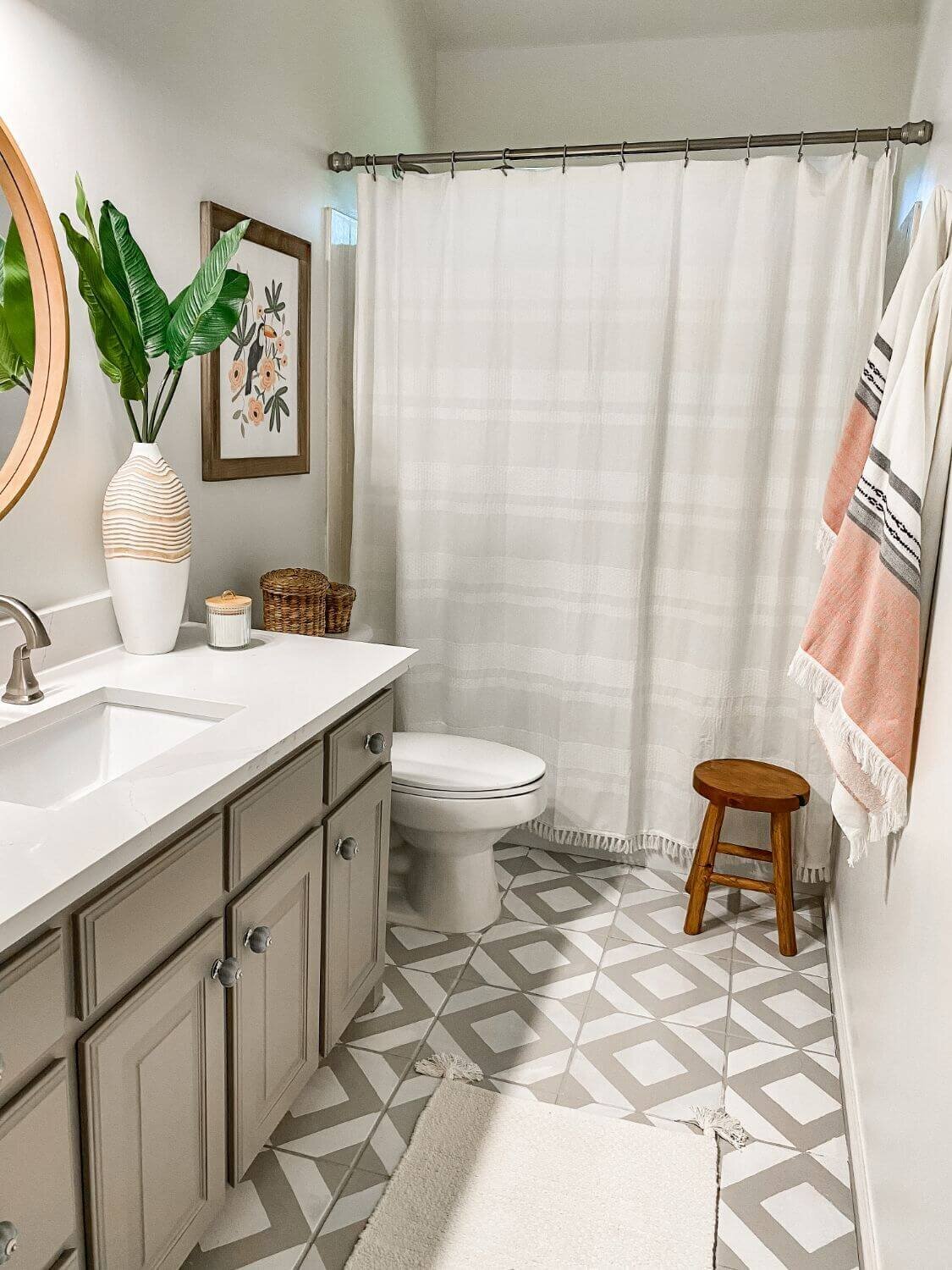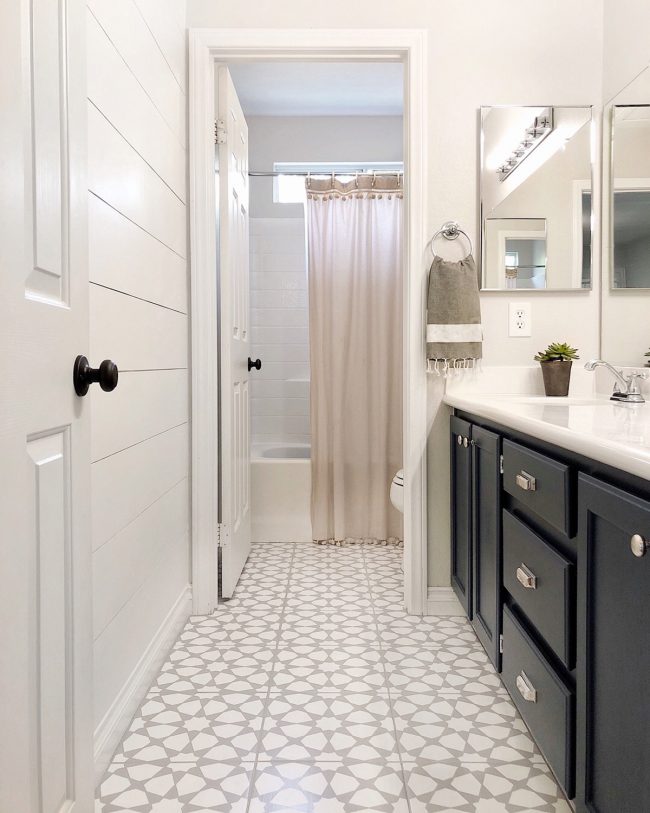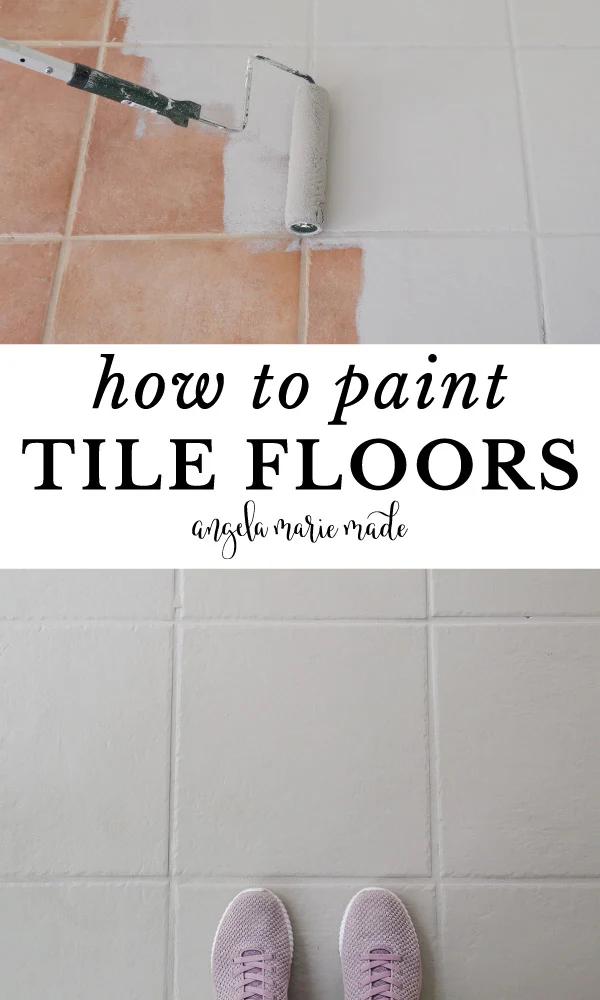Understanding Your Options: Temporary vs. Permanent Solutions
When it comes to covering a tile floor in the bathroom, homeowners often decide between temporary and permanent solutions. Each option has its own advantages and drawbacks, depending on factors like budget, time, and the desired longevity of the new floor covering. Here’s a detailed look at temporary and permanent solutions to help you make an informed decision.
- Temporary Solutions: Temporary solutions are ideal for renters or those who want a quick and reversible upgrade. Options like peel-and-stick tiles, vinyl flooring, and rugs provide a fresh look without the commitment of a permanent installation. These solutions are typically easy to install and remove, making them a great choice for people who like to change their decor frequently or plan to move in the near future.
- Peel-and-Stick Tiles: Peel-and-stick tiles are a popular temporary solution because they are easy to apply and come in a wide range of designs. They adhere directly to the existing tile, covering it completely. These tiles are also water-resistant, making them suitable for bathroom environments. However, they might not last as long as more permanent options and can sometimes peel if not properly installed.
- Vinyl Flooring: Vinyl flooring can be both a temporary and permanent solution, depending on the installation method. Loose-lay vinyl, for instance, can be easily removed and replaced, while glue-down vinyl offers a more permanent fix. Vinyl is durable, water-resistant, and comes in various styles, including those that mimic natural materials like wood or stone.
- Rugs and Mats: For a truly temporary and flexible solution, rugs and mats can be placed over tile floors to add warmth, comfort, and style. These are especially useful in areas where you stand frequently, like in front of the sink or shower. They can be easily cleaned or replaced, making them a convenient option for those looking to refresh their bathroom decor without any installation.
- Permanent Solutions: Permanent solutions involve more extensive work and a higher budget but offer a long-lasting result. Options like laminate flooring, tile overlays, or painting the tiles provide a durable finish that can stand up to the wear and tear of daily use. These methods often require more preparation and installation time but result in a more polished and integrated look.
- Choosing the Right Option: Deciding between temporary and permanent solutions depends on your specific needs and circumstances. If you prioritize flexibility and ease of installation, temporary solutions might be the best choice. However, if you want a long-lasting, durable finish and are willing to invest more time and money, permanent solutions will likely be more satisfying in the long run.

Vinyl Flooring: A Versatile and Affordable Choice
Vinyl flooring has become a popular option for covering tile floors in bathrooms due to its versatility, affordability, and ease of installation. This type of flooring comes in various styles, including sheets, tiles, and planks, each offering different benefits. Here’s an in-depth look at why vinyl flooring might be the perfect choice for your bathroom.
Variety of Styles Vinyl flooring is available in an array of designs, colors, and patterns. Whether you prefer the look of wood, stone, or ceramic, there’s a vinyl option that can mimic these materials convincingly. This variety allows you to achieve the aesthetic you desire without the cost and maintenance associated with natural materials.
Water Resistance One of the main reasons vinyl is suitable for bathrooms is its excellent water resistance. Vinyl flooring is designed to withstand moisture, making it an ideal choice for wet environments. This characteristic helps prevent issues like warping, mold, and mildew, which are common in bathrooms with improper flooring.
Ease of Installation Vinyl flooring is relatively easy to install, especially for DIY enthusiasts. Peel-and-stick vinyl tiles and planks can be directly adhered to the existing tile floor, while sheet vinyl can be cut to fit the room and laid down with minimal effort. This ease of installation makes vinyl a cost-effective solution since you can save on professional installation fees.
Comfort and Durability Vinyl flooring offers a comfortable underfoot feel, which is a significant advantage in spaces where you spend a lot of time standing, like the bathroom. Additionally, it’s durable and can withstand heavy foot traffic, making it a practical choice for busy households. High-quality vinyl can last for many years with proper care.
Low Maintenance Keeping vinyl flooring clean is straightforward. Regular sweeping and occasional mopping are typically all that’s needed to maintain its appearance. This low-maintenance quality is particularly beneficial in bathrooms, where frequent cleaning is necessary to keep the space hygienic.
Cost-Effective Vinyl flooring is one of the most affordable flooring options on the market. It provides a cost-effective way to update your bathroom without breaking the bank. The combination of affordability, durability, and aesthetic variety makes vinyl flooring a smart choice for many homeowners looking to cover their tile floors.
Laminate Flooring: Durable and Easy to Install
Laminate flooring is another excellent option for covering tile floors in bathrooms. Known for its durability and ease of installation, laminate can transform the look of your bathroom while providing a practical and long-lasting solution. Here’s why laminate flooring might be the right choice for your bathroom renovation.
Aesthetic Appeal Laminate flooring is designed to replicate the appearance of natural materials like wood and stone. Advances in printing technology have made it possible to create highly realistic textures and patterns, giving you the look of expensive flooring at a fraction of the cost. This aesthetic versatility allows you to achieve the desired style for your bathroom.
Durability Laminate flooring is renowned for its durability. It is constructed with multiple layers that provide strength and resistance to wear and tear. The top layer is typically a clear protective coating that shields the floor from scratches, dents, and stains. This makes laminate an excellent choice for high-traffic areas like bathrooms.
Water Resistance While traditional laminate flooring was not recommended for wet areas, newer water-resistant and waterproof laminate options are now available. These advanced laminates are designed to handle moisture better, making them suitable for bathrooms. It’s essential to choose a laminate product specifically rated for wet environments to ensure longevity.
Ease of Installation Laminate flooring is known for its straightforward installation process, often using a click-and-lock system. This method allows the planks to snap together without the need for glue or nails, making it a suitable project for DIYers. Additionally, laminate can be installed over existing tile floors, saving time and effort on floor preparation.
Comfort Underfoot Laminate flooring provides a comfortable surface to walk on, which is particularly beneficial in a bathroom setting. Some laminate options come with an attached underlayment that adds cushioning and reduces noise. This makes the floor more pleasant to stand on and can improve the overall comfort of the bathroom.
Maintenance and Care Maintaining laminate flooring is easy, which is a significant advantage in a bathroom. Regular sweeping and damp mopping are usually sufficient to keep the floor clean. Avoid using excessive water when cleaning, and promptly wipe up any spills to prevent moisture damage. With proper care, laminate flooring can retain its appearance and functionality for many years.
Painted Tile: Transforming Your Floor with a Fresh Coat
If you’re looking to cover your tile floor without the hassle of installing new flooring, painting the tiles can be an effective and creative solution. Painting tile floors allows you to completely change the look of your bathroom with a relatively simple and cost-effective process. Here’s a step-by-step guide to transforming your tile floor with paint.
Preparation Proper preparation is crucial for a successful tile painting project. Start by thoroughly cleaning the tiles to remove any dirt, grease, or soap residue. Use a heavy-duty cleaner and a scrub brush to ensure the surface is spotless. After cleaning, allow the tiles to dry completely. Sanding the tiles lightly with fine-grit sandpaper can help the paint adhere better by roughening the surface slightly.
Priming the Tiles Applying a high-quality primer is essential to ensure the paint adheres properly and lasts longer. Use a primer specifically designed for glossy surfaces or tiles. Apply the primer evenly with a paint roller or brush, ensuring full coverage. Allow the primer to dry according to the manufacturer’s instructions before moving on to the next step.
Choosing the Right Paint Selecting the right type of paint is vital for durability and appearance. Epoxy or latex paints are recommended for tile floors due to their durability and water resistance. Epoxy paint is particularly tough and can withstand the wear and tear of a bathroom environment. Choose a color that complements your bathroom decor and gives the space a fresh, updated look.
Painting the Tiles Once the primer is dry, you can begin painting. Use a high-quality paintbrush or roller to apply the paint evenly. Depending on the color and type of paint, you may need to apply multiple coats to achieve full coverage. Allow each coat to dry thoroughly before applying the next. Be patient and take your time to ensure a smooth, even finish.
Sealing the Paint After the final coat of paint has dried, apply a clear sealant to protect the painted surface. A polyurethane or epoxy sealant works well for this purpose. The sealant will add a layer of protection against moisture, scratches, and stains, helping the painted tiles maintain their appearance and durability. Apply the sealant according to the manufacturer’s instructions and allow it to cure fully.
Maintenance Maintaining painted tile floors involves regular cleaning to keep them looking their best. Use a gentle, non-abrasive cleaner and avoid harsh chemicals that can damage the paint. Place rugs or mats in high-traffic areas to protect the painted surface from wear. With proper care, your painted tile floor can remain beautiful and functional for years to come.
Peel-and-Stick Tiles: Quick and Stylish Upgrades
Peel-and-stick tiles offer a fast and stylish way to cover tile floors in the bathroom. These self-adhesive tiles are easy to install, come in various designs, and provide an instant facelift to your bathroom without the need for professional help. Here’s why peel-and-stick tiles might be the perfect solution for your bathroom floor.
Easy Installation One of the most significant advantages of peel-and-stick tiles is their ease of installation. These tiles come with a self-adhesive backing, allowing you to peel off the protective layer and stick the tiles directly onto the existing floor. This makes them an ideal choice for DIY projects and quick renovations, as no special tools or skills are required.
Variety of Designs Peel-and-stick tiles are available in a wide range of designs, colors, and patterns, allowing you to customize the look of your bathroom easily. Whether you prefer a classic marble look, trendy geometric patterns, or a rustic wood finish, there’s a peel-and-stick tile to suit your style. This variety ensures you can achieve the desired aesthetic without the cost of traditional materials.
Affordability Peel-and-stick tiles are an affordable flooring option compared to other materials like ceramic or stone. They provide a cost-effective way to update your bathroom floor, making them a popular choice for budget-conscious homeowners. Despite their lower price point, many peel-and-stick tiles offer impressive durability and quality.
Water Resistance Many peel-and-stick tiles are designed to be water-resistant, making them suitable for bathroom environments. This feature helps protect the underlying floor from moisture damage, which is crucial in a space prone to spills and humidity. Ensure you choose tiles specifically rated for use in wet areas to maximize their longevity.
Low Maintenance Keeping peel-and-stick tiles clean is straightforward. Regular sweeping and mopping with a mild cleaner are usually sufficient to maintain their appearance. This low-maintenance quality makes them a practical choice for busy households where frequent cleaning is necessary to keep the bathroom hygienic.
Temporary Solution If you’re renting or planning to renovate your bathroom again in the future, peel-and-stick tiles offer a temporary solution that can be easily removed without damaging the underlying surface. This flexibility allows you to update your bathroom’s look without a long-term commitment, making it a convenient option for those who like to change their decor frequently.
Rugs and Mats: Adding Comfort and Style to Your Bathroom Floor
Rugs and mats are a simple yet effective way to cover tile floors in the bathroom, adding both comfort and style. They offer a versatile and flexible solution that can enhance the overall look of your bathroom while providing practical benefits. Here’s how rugs and mats can transform your bathroom floor.
Comfort Underfoot One of the primary benefits of adding rugs and mats to your bathroom floor is the enhanced comfort they provide. Stepping onto a soft, cushioned surface is much more pleasant than cold, hard tiles, especially during the colder months. Bathroom rugs and mats are designed to be absorbent, providing a dry and comfortable surface to stand on after a shower or bath.
Variety of Styles Rugs and mats come in a wide range of styles, colors, and patterns, allowing you to personalize your bathroom decor easily. Whether you prefer a minimalist look, bold patterns, or something in between, there’s a rug or mat to suit your taste. This variety makes it easy to find pieces that complement your existing decor and add a touch of personality to your bathroom.
Protection for Your Floor Placing rugs and mats in high-traffic areas can help protect your tile floor from wear and tear. They can prevent scratches, chips, and other damage caused by daily use. Additionally, mats placed near the sink or shower can catch water spills, reducing the risk of water damage to the tiles and grout.
Easy Maintenance Bathroom rugs and mats are generally easy to clean and maintain. Most can be machine-washed or spot-cleaned, making them a practical choice for busy households. Regular cleaning helps keep them looking fresh and hygienic, ensuring your bathroom remains a clean and inviting space.
Safety Adding rugs and mats to your bathroom floor can enhance safety by reducing the risk of slips and falls. Look for rugs with non-slip backings that stay securely in place, even in wet conditions. This is particularly important in a bathroom, where water spills and damp floors can create hazardous conditions.
Affordability and Flexibility Rugs and mats are an affordable way to update your bathroom floor without the need for a major renovation. They offer flexibility, as you can easily change them out to refresh the look of your bathroom whenever you like. This makes them an excellent option for those who enjoy updating their decor regularly or want a temporary solution.
How to Paint Tile Floors
Cheap Bathroom Floor Makeover Easy DIY
How to Paint Tile Floors Painting tile, Painting bathroom tiles
How to Cover Ugly Mosaic Tile Floors: The Easy u0026 RENTER-FRIENDLY
DIY: How to Paint Ceramic Floor Tile u2014 Farmhouse Living
How To Update Your Bathroom Floor Tiles – 6 DIY ideas
How To Paint A Bathroom Floor To Look Like Cement Tile
How to Paint Tile Floor – Angela Marie Made
Related Posts:
- Can I Use My Bissell Carpet Cleaner On Tile Floors
- What Type Of Mop To Use On Tile Floors
- How To Polish Ceramic Tile Floors
- Best Home Tile Floor Scrubber
- Pressure Wash Tile Floor
- Click Lock Tile Flooring
- Scrub Brush For Tile Floor
- How To Wax A Commercial Tile Floor
- Natural Ceramic Tile Floor Cleaner
- Best Vacuum For Laminate And Tile Floors
